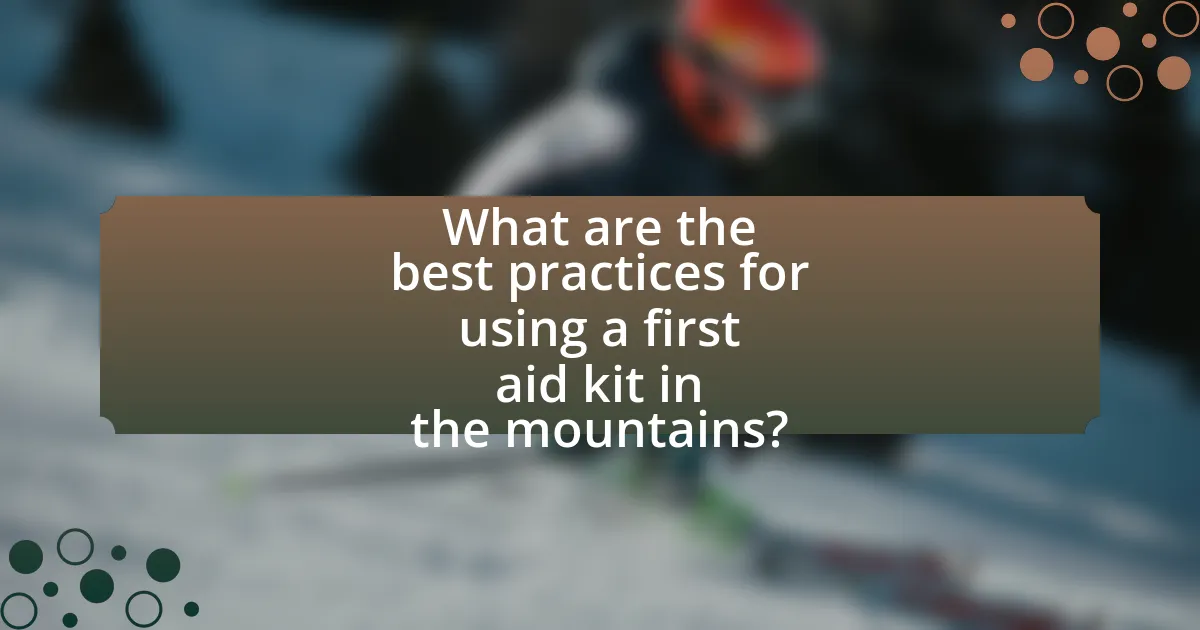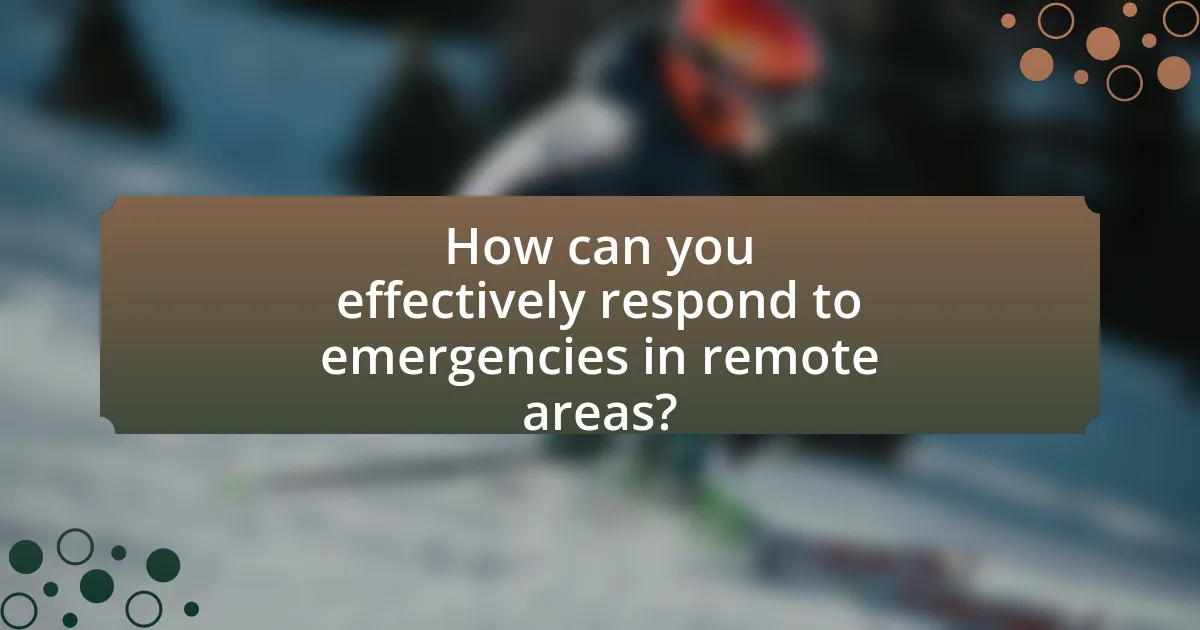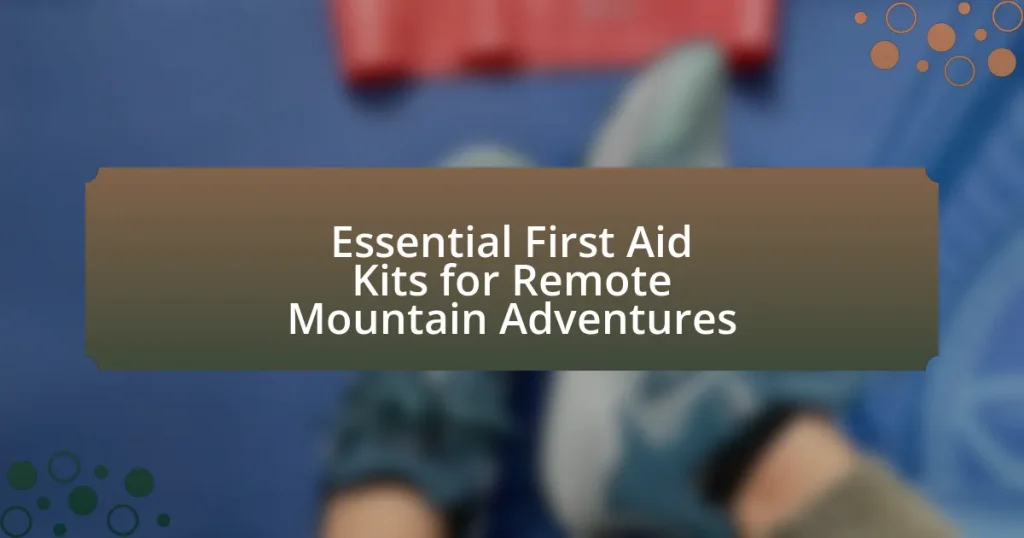Essential first aid kits for remote mountain adventures are crucial for addressing injuries and emergencies in isolated environments. These kits should include items such as adhesive bandages, sterile gauze pads, antiseptic wipes, pain relievers, and specialized tools like splints and CPR face shields. The article outlines the importance of being prepared for common injuries, the types of injuries that can occur in mountainous terrains, and best practices for selecting and maintaining a first aid kit. Additionally, it emphasizes the significance of training and familiarization with first aid techniques to enhance safety during outdoor activities.

What are Essential First Aid Kits for Remote Mountain Adventures?
Essential first aid kits for remote mountain adventures include items specifically designed to address injuries and emergencies that may occur in isolated environments. A comprehensive kit should contain adhesive bandages, sterile gauze pads, antiseptic wipes, medical tape, scissors, tweezers, a CPR face shield, a triangular bandage, and a first aid manual. Additionally, it is crucial to include items like pain relievers, allergy medication, blister treatment, and a splint for fractures.
The inclusion of these items is supported by guidelines from organizations such as the American Red Cross, which emphasizes the importance of being prepared for common injuries in outdoor settings. For instance, adhesive bandages and gauze pads are essential for treating cuts and abrasions, while pain relievers can help manage discomfort during an adventure. Having a well-stocked first aid kit can significantly enhance safety and preparedness in remote mountain areas.
Why is a first aid kit crucial for mountain adventures?
A first aid kit is crucial for mountain adventures because it provides essential medical supplies to address injuries and emergencies that may occur in remote locations. In mountainous terrains, access to professional medical help can be delayed, making immediate care vital. For instance, a study by the Wilderness Medical Society highlights that injuries such as sprains, fractures, and cuts are common in outdoor activities, and having a first aid kit allows adventurers to manage these situations effectively until further help is available. Additionally, the unpredictable nature of mountain environments increases the risk of accidents, reinforcing the necessity of being prepared with a comprehensive first aid kit.
What types of injuries can occur in remote mountain settings?
In remote mountain settings, common types of injuries include fractures, sprains, hypothermia, altitude sickness, and lacerations. Fractures and sprains often occur due to falls or slips on uneven terrain, with studies indicating that approximately 30% of hiking injuries are related to these incidents. Hypothermia can develop from prolonged exposure to cold and wet conditions, while altitude sickness arises from rapid ascent to high elevations, affecting around 20% of climbers. Lacerations may result from sharp rocks or equipment, contributing to the need for comprehensive first aid kits tailored for such environments.
How can a first aid kit mitigate risks during outdoor activities?
A first aid kit can mitigate risks during outdoor activities by providing essential medical supplies to address injuries and emergencies promptly. These kits typically include items such as bandages, antiseptics, and pain relievers, which enable individuals to treat cuts, scrapes, and other minor injuries on-site, reducing the likelihood of complications. For instance, a study published in the Journal of Wilderness Medicine highlights that immediate treatment of injuries can significantly decrease recovery time and prevent infections, thereby enhancing safety during outdoor excursions.
What are the key components of an essential first aid kit?
An essential first aid kit for remote mountain adventures includes items that address common injuries and emergencies. Key components are adhesive bandages for cuts, sterile gauze pads for larger wounds, antiseptic wipes to clean injuries, adhesive tape to secure dressings, and scissors for cutting tape or clothing. Additionally, a triangular bandage can be used for slings or securing splints, while a cold pack helps reduce swelling. Pain relief medication, such as ibuprofen or acetaminophen, is also crucial. A first aid manual provides guidance on treating various injuries. These components are vital for effectively managing injuries in remote settings, where immediate medical assistance may not be available.
What basic supplies should every first aid kit include?
Every first aid kit should include adhesive bandages, sterile gauze pads, adhesive tape, antiseptic wipes, scissors, tweezers, a digital thermometer, and a first aid manual. These supplies are essential for treating minor injuries and managing emergencies effectively. For instance, adhesive bandages and sterile gauze pads are crucial for covering wounds, while antiseptic wipes help prevent infections. Scissors and tweezers assist in removing splinters or cutting tape, and a digital thermometer is vital for monitoring body temperature. A first aid manual provides guidance on how to respond to various medical situations, ensuring preparedness in remote mountain adventures.
How do specialized items enhance the effectiveness of a first aid kit?
Specialized items enhance the effectiveness of a first aid kit by providing targeted solutions for specific injuries and emergencies encountered in remote mountain adventures. For instance, items such as splints, tourniquets, and emergency blankets are designed to address particular medical situations, improving the likelihood of successful treatment. Research indicates that the inclusion of specialized tools can significantly reduce the time to stabilize injuries, which is crucial in remote settings where professional medical help may be delayed. Additionally, having items like snake bite kits or altitude sickness medications can directly address risks associated with mountainous environments, thereby increasing the overall preparedness and safety of adventurers.
How do you choose the right first aid kit for your adventure?
To choose the right first aid kit for your adventure, assess the specific needs of your activity and environment. Consider factors such as the duration of the trip, the number of participants, and the types of injuries that may occur in remote mountain settings. A comprehensive kit should include items like adhesive bandages, antiseptic wipes, gauze pads, and a splint, as these are essential for treating common injuries like cuts, scrapes, and fractures. Additionally, ensure the kit is compact, lightweight, and waterproof to withstand outdoor conditions. According to the Wilderness Medical Society, a well-stocked first aid kit can significantly improve outcomes in emergency situations, making it crucial for safety during outdoor adventures.
What factors should be considered when selecting a first aid kit?
When selecting a first aid kit for remote mountain adventures, consider the specific needs of the environment and activities planned. Essential factors include the size and weight of the kit, as portability is crucial in remote areas; the contents, which should include items for treating common injuries such as cuts, sprains, and altitude sickness; and the number of people in the group, as larger groups require more supplies. Additionally, ensure the kit is waterproof and durable to withstand harsh conditions, and check for expiration dates on medical supplies to ensure effectiveness. These considerations are vital for ensuring safety and preparedness during outdoor activities.
How does the duration and location of the adventure influence kit selection?
The duration and location of an adventure significantly influence kit selection by determining the types and quantities of supplies needed for safety and medical care. For instance, longer adventures require more extensive supplies, such as additional medications and bandages, to address potential injuries or illnesses over time. Conversely, shorter trips may necessitate a more compact kit with essential items only. Additionally, the location impacts the kit’s contents; remote mountain areas may require specialized gear like splints or altitude sickness medication due to the unique risks associated with such environments. Research indicates that outdoor activities in remote areas often lead to higher injury rates, emphasizing the need for comprehensive first aid kits tailored to specific conditions and durations.

What are the best practices for using a first aid kit in the mountains?
The best practices for using a first aid kit in the mountains include ensuring the kit is well-stocked with essential supplies, familiarizing yourself with its contents, and knowing how to use each item effectively. A well-stocked kit should contain items such as adhesive bandages, antiseptic wipes, gauze pads, and a splint, as these are crucial for treating common injuries like cuts, scrapes, and fractures. Familiarity with the kit allows for quick access to necessary items during emergencies, which is vital in remote areas where help may be far away. Additionally, understanding how to perform basic first aid procedures, such as applying pressure to a wound or immobilizing a fracture, enhances the effectiveness of the kit in real-life situations.
How should you prepare your first aid kit before a trip?
To prepare your first aid kit before a trip, ensure it contains essential medical supplies tailored to potential injuries and ailments you may encounter. Include items such as adhesive bandages, antiseptic wipes, gauze pads, adhesive tape, scissors, tweezers, pain relievers, and any personal medications. Additionally, consider including a first aid manual for guidance on treating injuries. According to the American Red Cross, a well-stocked first aid kit can significantly improve response times to injuries, making it crucial for outdoor adventures.
What steps can ensure your kit is fully stocked and functional?
To ensure your first aid kit is fully stocked and functional, regularly inventory its contents and replace any expired or used items. Conducting a thorough check every few months allows you to identify missing supplies and ensure that medications, bandages, and other essentials are within their effective dates. Research indicates that a well-maintained first aid kit can significantly improve response times and outcomes in emergency situations, particularly in remote areas where access to medical help is limited.
How can you familiarize yourself with the contents of your kit?
To familiarize yourself with the contents of your first aid kit, systematically review the kit’s inventory list and practice using each item. This approach ensures that you understand the purpose and application of each component, which is crucial for effective use in emergencies. For example, knowing how to apply a tourniquet or use antiseptic wipes can significantly impact the outcome of a medical situation. Regularly checking the kit for expiration dates and replacing items as needed also reinforces familiarity and preparedness.
What are common mistakes to avoid with first aid kits?
Common mistakes to avoid with first aid kits include neglecting to regularly check and restock supplies, failing to customize the kit for specific activities, and not ensuring that all users are familiar with its contents. Regularly checking supplies is crucial, as items like medications and bandages can expire or become ineffective over time. Customizing the kit for specific activities, such as mountain adventures, ensures that it contains relevant items like splints or altitude sickness medication. Familiarity with the kit’s contents allows users to respond quickly and effectively in emergencies, enhancing safety during remote excursions.
Why is it important to regularly check and update your first aid kit?
Regularly checking and updating your first aid kit is crucial to ensure that all supplies are current and effective in emergencies. Over time, items can expire, become damaged, or be used up, which compromises the kit’s ability to provide necessary care. For instance, medications and antiseptics often have specific expiration dates, and using expired products can lead to ineffective treatment. Additionally, regularly updating the kit allows for the inclusion of new items that may be relevant to specific activities or environments, such as specialized bandages for mountain injuries. This proactive approach enhances safety and preparedness during remote mountain adventures, where timely medical assistance may not be readily available.
What items are often overlooked but essential for mountain adventures?
Items often overlooked but essential for mountain adventures include a multi-tool, emergency whistle, and a compact first aid kit. A multi-tool provides various functions such as cutting, screwing, and opening bottles, which can be crucial in remote settings. An emergency whistle is vital for signaling for help, as it can be heard over long distances, unlike a human voice. A compact first aid kit is essential for treating injuries, and many adventurers neglect to pack items like antiseptic wipes, adhesive bandages, and pain relievers, which are critical for managing minor injuries and preventing infections.

How can you effectively respond to emergencies in remote areas?
To effectively respond to emergencies in remote areas, individuals should prioritize preparation, communication, and resource management. Preparation involves carrying a comprehensive first aid kit tailored for remote environments, which includes essential supplies such as bandages, antiseptics, and medications. Communication is crucial; utilizing satellite phones or two-way radios ensures that help can be summoned quickly. Resource management entails knowing how to use the available supplies efficiently and understanding basic first aid techniques, which can significantly improve outcomes in emergencies. Studies indicate that well-prepared individuals in remote settings can reduce the severity of injuries and improve survival rates by up to 50%.
What are the first steps to take in an emergency situation?
In an emergency situation, the first steps to take are to ensure personal safety, assess the situation, and call for help if necessary. Personal safety involves moving away from any immediate danger, such as fire or unstable structures. Assessing the situation includes identifying the nature of the emergency, checking for injuries, and determining the resources available. Calling for help, such as contacting emergency services, is crucial if the situation requires professional assistance. These steps are essential for effective emergency response and can significantly impact the outcome of the situation.
How can you assess the severity of an injury in the field?
To assess the severity of an injury in the field, first evaluate the patient’s level of consciousness, airway, breathing, and circulation. This primary assessment helps identify life-threatening conditions. Next, examine the injury site for visible signs such as swelling, deformity, or bleeding. Use the AVPU scale (Alert, Verbal, Pain, Unresponsive) to gauge responsiveness, which indicates the severity of the injury. For example, a patient who is unresponsive may have a more severe injury than one who is alert. Additionally, consider the mechanism of injury; high-impact injuries often result in more severe damage. Finally, monitor vital signs, as changes can indicate worsening conditions. These methods are supported by established first aid protocols, which emphasize systematic assessment to ensure appropriate care.
What communication methods are available for emergencies in remote areas?
In emergencies in remote areas, available communication methods include satellite phones, two-way radios, and personal locator beacons (PLBs). Satellite phones provide reliable voice communication and can function in areas without cellular coverage, making them essential for remote locations. Two-way radios allow for instant communication over short distances and are often used in group settings, such as hiking or climbing expeditions. Personal locator beacons enable users to send distress signals to emergency services, providing GPS coordinates for rescue operations. These methods are critical for ensuring safety and facilitating timely assistance in isolated environments.
What additional training can enhance your first aid skills?
Advanced first aid training, such as Wilderness First Aid (WFA) or Wilderness First Responder (WFR), can significantly enhance your first aid skills. These specialized courses focus on emergency care in remote settings, teaching skills like patient assessment, trauma management, and environmental injury treatment. According to the Wilderness Medical Society, individuals trained in WFA or WFR are better equipped to handle medical emergencies in isolated areas, where access to professional medical help may be delayed.
How can wilderness first aid courses benefit outdoor adventurers?
Wilderness first aid courses benefit outdoor adventurers by equipping them with essential skills to manage medical emergencies in remote settings. These courses teach participants how to assess injuries, perform CPR, and stabilize patients until professional help arrives, which is crucial in wilderness environments where immediate medical assistance may not be available. For instance, a study by the Wilderness Medical Society found that individuals trained in wilderness first aid are significantly more confident in their ability to handle emergencies, leading to better outcomes in critical situations. This training not only enhances personal safety but also fosters a culture of preparedness among outdoor enthusiasts.
What resources are available for learning first aid techniques?
Resources available for learning first aid techniques include online courses, instructional videos, and printed manuals. Organizations such as the American Red Cross and St. John Ambulance offer comprehensive first aid training programs that cover essential skills and techniques. Additionally, platforms like Coursera and Udemy provide access to various first aid courses taught by certified instructors. Printed materials, such as the “First Aid Manual” published by the British Red Cross, serve as valuable references for learners. These resources ensure individuals are equipped with the knowledge and skills necessary to respond effectively in emergency situations.
What practical tips can improve your first aid preparedness?
To improve first aid preparedness, individuals should regularly review and update their first aid kits, ensuring they contain essential supplies tailored to specific activities and environments. Regularly checking expiration dates on items like bandages, antiseptics, and medications is crucial, as outdated supplies can compromise care. Additionally, taking a certified first aid and CPR course enhances knowledge and skills, enabling effective response in emergencies. Research indicates that individuals trained in first aid are more confident and capable in crisis situations, significantly improving outcomes. Furthermore, creating a first aid plan that includes emergency contacts and procedures specific to remote mountain adventures ensures readiness for various scenarios.
